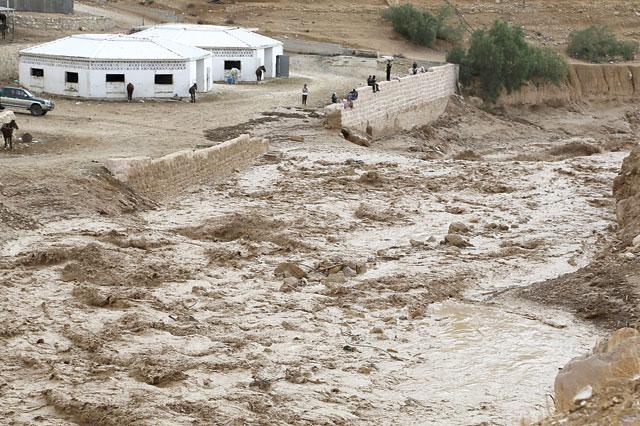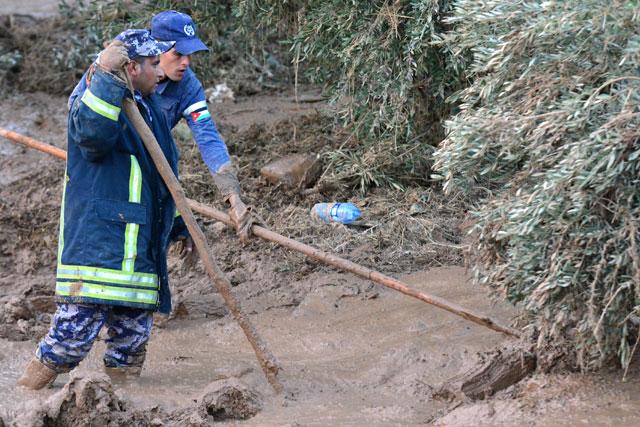You are here
Floods 'only beginning' of severe climate change impacts on Jordan
By Hana Namrouqa - Nov 11,2018 - Last updated at Nov 11,2018

This photo taken on Saturday, in Petra, 235km south of Amman, shows the effects of flashfloods that killed several people across the region (AFP photo)
AMMAN — As Jordan was still licking its wounds after last month’s Dead Sea tragedy, flashfloods struck again this weekend, claiming new lives in what experts on climate change described as "only the beginning" of severe manifestations of climate change impacts on Jordan and the region.
The experts said that climate change is making flashfloods in Jordan much worse, indicating that extreme weather events, flashfloods in this case, are outpacing time projections of climate change impacts on Jordan.
On October 25, only 15 minutes of rain formed killer flashfloods which swept 21 people, including 16 schoolchildren, to their death in the Zarqa-Maeen Valley in the Dead Sea area. Three weeks later, heavy quick rain due to unstable weather conditions produced flashfloods which killed 12 people, injured 29 and inundated more than 1,100 people, who were evacuated by authorities between Friday and Saturday.
Batir Wardam, an expert on climate change who has been working in the field for the past 10 years, said that Jordan prepared, four years ago, its national communication to the United Nations Convention on Climate Change, which suggested, based on analysis of rainfall patterns and a 30-year weather forecast, that Jordan will witness a shift, under which precipitation in the southern region of the Kingdom and flashflooding will increase.
“But the timeframe [of the shift] was after ten years. What is surprising is that the timeframe [of the shift] was accelerated. Thus, it is proven to a high degree of certainty — not to say completely proven — that flashfloods are brought on by climate change,” Wardam told The Jordan Times on Saturday.
Every four years, Jordan publishes a national communication report on climate change to provide a scientifically sound description of the projected impact of climate change on the country over the years, as well as a comprehensive mitigation assessment.
The latest report warned that Jordan would witness a steady increase in temperatures, an increase in dry spells, a drop in precipitation frequency and an increase in intensity in the coming decades, as the impact of global warming becomes more apparent.
In Jordan, there is a misconception that climate change happens in other regions of the world and that the country is irrelevant to the phenomenon; Wardam noted, adding that another faulty notion is that if climate change is actually affecting the country, it would be manifested in rising temperatures and the overall amounts of rain.
“What is happening is that precipitation amounts are actually decreasing, but when it does rain, it rains with higher intensity,” Wardam underlined.
The expert said that climate change should be on top of the Kingdom’s development priorities, stressing the need for a nation-wide map of flashflood-endangered areas.
“A map of areas prone to flashfloods and drought spells should be drafted,” he advised.
Studies show that certain parts in the Jordan Valley, the northern region and Shobak in Tafileh Governorate are vulnerable to climate change, but more thorough mapping that involves weather forecasting and the topography of hazard areas is necessary, the expert added.
He urged for creating a risk map for each of Jordan’s governorates to identify high-risk areas in cases of droughts and flashfloods in order to reach people and warn them, as well as to avoid the construction of roads or buildings in areas where inundation and other extreme weather events are possible.
“Without such mapping on climate risk areas, any endeavour in this regard will be random,” he warned.
Safa Jayoussi, a climate change expert, said that while climate change is not the only culprit in the killer flashfloods that claimed the lives of 33 people in three weeks, it is definitely a serious and growing threat to the Kingdom.
Jayoussi highlighted that severe and intense flashfloods have been expected to happen in Jordan for so many years, noting that decision makers should actually start taking climate change more seriously.
“Did we have to lose so many lives for us to actually believe and consider that climate change is really happening!”Jayoussi told The Jordan Times.
The latest United Nations Intergovernmental Panel on Climate Change (IPCC) report indicates that this region, Jordan included, will witness less rainy days, however, much more intense precipitation, Jayoussi said.
The IPCC report highlights a number of climate change impacts that could be avoided by limiting global warming to 1.5ºC compared to 2ºC, or more.
But Jayoussi said that the same report indicates that “there is medium confidence that a global warming of 2°C would lead to an expansion of areas with significant increases in run-off as well as those affected by flood hazard, as compared to conditions at 1.5°C global warming.”
“This means that whether or not climate change causes are controlled, Jordan would still suffer from the consequences,” she noted.
The expert urged creating an early alarm system and the creation of a local climate change fund.
Meanwhile, head of the weather forecasting directorate at the Jordan Meteorological Department Raed Rafed said that Jordan has been witnessing much more severe flashfloods over the past four years.
Unstable weather conditions, which Jordan experiences during the change between seasons, usually bring heavy torrential rain that result in flashfloods.
“Unstable weather conditions are a serious matter and they are dangerous,” Rafed said.
They happen when high surface temperatures coincide with cold upper troughs, he explained.
“We, of course, cannot rule out the fact that Jordan is seeing shifting climatic patterns and that this is the result of climate change,” Rafed told The Jordan Times.
The meteorologist said that further scientific research is required to measure the impact of climate change on Jordan.
“I expect more states of unstable weather conditions, and I expect them to be strong,” Rafed said.
Related Articles
AMMAN — The Kingdom on Sunday night received its first drops of the wet season, according to meteorologists, who said that the precipitation
AMMAN — A group of six men who were stranded in Maan Governorate’s Jafer area following Friday’s flashfloods were rescued and evacuated on S
AMMAN — With Jordan’s first National Adaptation Plan (NAP) projected to be finalised later this year, experts are formulating NAP’s communic













